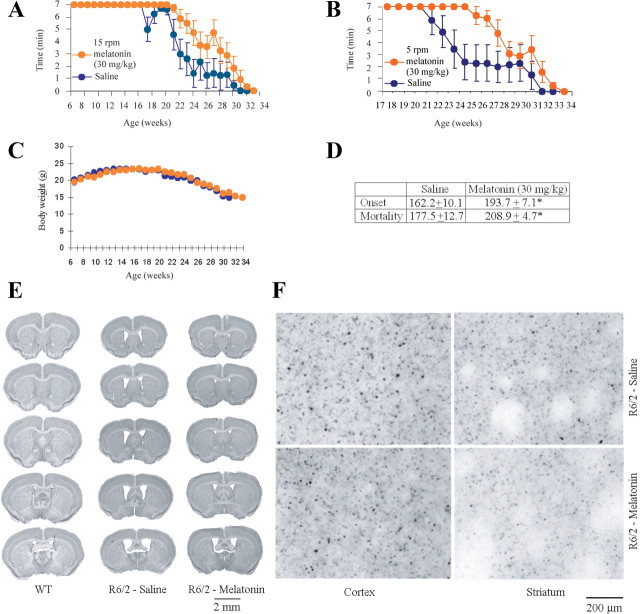Figure 4.
Melatonin slows disease progression in R6/2 mice. A, B, Treatment from 6 weeks of age with 30 mg · kg−1 · d−1 melatonin improves rotarod performance of R6/2 mice. Both melatonin- and saline-injected R6/2 littermates are challenged to remain for up to 7 min on a rotarod turning at 15 rpm (A) or 5 rpm (B). Data for many of the weekly tests show a statistically significant difference of rotarod performance of saline- and melatonin-treated R6/2 mice. When rotation is 15 rpm, we observe p < 0.05 for weeks 21, 22, and 25 and p < 0.001 for weeks 26–29. At 5 rpm, we find p < 0.05 for weeks 22, 28, and 29 and p < 0.001 for weeks 23–27. C, Weekly values for body weight are statistically indistinguishable between melatonin-treated animals and saline controls. D, The table summarizes data for the melatonin- and saline-treated groups (A–D, n = 9 and 6, respectively). Both the age at disease onset (i.e., when first the mouse falls from the rotarod before 7 min have elapsed) and that at death are greater for melatonin-treated mice (*p < 0.01). E, Melatonin reduces ventricular enlargement in the brains of R6/2 mice. The figure shows coronal sections from 25-week-old R6/2 mice treated with melatonin or the saline vehicle, as well as ones from age-matched wild-type littermates (n ≥ 3). F, Brain sections were prepared from 25-week-old R6/2 mice that had been treated with 30 mg · ml−1 · d−1 melatonin or saline. Slices of both cortical and striatal tissue were stained with anti-huntingtin antibodies. In both cases, any reduction in the extent of huntingtin aggregation was not statistically significant.

